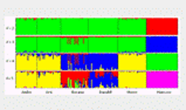In total, 166 individuals from five indigenous Ethiopian cattle populations - Ambo (n = 27), Borana (n = 35), Arsi (n = 30), Horro (n = 36), and Danakil (n = 38) - were genotyped for 8773 single nucleotide polymorphism (SNP) markers to assess genetic diversity, population structure, and relationships. As a representative of taurine breeds, Hanwoo cattle (n = 40) were also included in the study for reference. Among Ethiopian cattle populations, the proportion of SNPs with minor allele frequencies (MAFs) ≥0.05 ranged from 81.63% in Borana to 85.30% in Ambo, with a mean of 83.96% across all populations. The Hanwoo breed showed the highest proportion of polymorphism, with MAFs ≥0.05, accounting for 95.21% of total SNPs. The mean expected heterozygosity varied from 0.370 in Danakil to 0.410 in Hanwoo. The mean genetic differentiation (F ST; 1%) in Ethiopian cattle revealed that within individual variation accounted for approximately 99% of the total genetic variation. As expected, F ST and Reynold genetic distance were greatest between Hanwoo and Ethiopian cattle populations, with average values of 17.62 and 18.50, respectively. The first and second principal components explained approximately 78.33% of the total variation and supported the clustering of the populations according to their historical origins. At K = 2 and 3, a considerable source of variation among cattle is the clustering of the populations into Hanwoo (taurine) and Ethiopian cattle populations. The low estimate of genetic differentiation (F ST) among Ethiopian cattle populations indicated that differentiation among these populations is low, possibly owing to a common historical origin and high gene flow. Genetic distance, phylogenic tree, principal component analysis, and population structure analyses clearly differentiated the cattle population according to their historical origins, and confirmed that Ethiopian cattle populations are genetically distinct from the Hanwoo breed.
In total, 166 individuals from five indigenous Ethiopian cattle populations - Ambo (n = 27), Borana (n = 35), Arsi (n = 30), Horro (n = 36), and Danakil (n = 38) - were genotyped for 8773 single nucleotide polymorphism (SNP) markers to assess genetic diversity, population structure, and relationships. As a representative of taurine breeds, Hanwoo cattle (...
In total, 166 individuals from five indigenous Ethiopian cattle populations - Ambo (n = 27), Borana (n = 35), Arsi (n = 30), Horro (n = 36), and Danakil (n = 38) - were genotyped for 8773 single nucleotide polymorphism (SNP) markers to assess genetic diversity, population structure, and relationships. As a representative of taurine breeds, Hanwoo cattle (n = 40) were also included in the study for reference. Among Ethiopian cattle populations, the proportion of SNPs with minor allele frequencies (MAFs) ≥0.05 ranged from 81.63% in Borana to 85.30% in Ambo, with a mean of 83.96% across all populations. The Hanwoo breed showed the highest proportion of polymorphism, with MAFs ≥0.05, accounting for 95.21% of total SNPs. The mean expected heterozygosity varied from 0.370 in Danakil to 0.410 in Hanwoo. The mean genetic differentiation (F ST; 1%) in Ethiopian cattle revealed that within individual variation accounted for approximately 99% of the total genetic variation. As expected, F ST and Reynold genetic distance were greatest between Hanwoo and Ethiopian cattle populations, with average values of 17.62 and 18.50, respectively. The first and second principal components explained approximately 78.33% of the total variation and supported the clustering of the populations according to their historical origins. At K = 2 and 3, a considerable source of variation among cattle is the clustering of the populations into Hanwoo (taurine) and Ethiopian cattle populations. The low estimate of genetic differentiation (F ST) among Ethiopian cattle populations indicated that differentiation among these populations is low, possibly owing to a common historical origin and high gene flow. Genetic distance, phylogenic tree, principal component analysis, and population structure analyses clearly differentiated the cattle population according to their historical origins, and confirmed that Ethiopian cattle populations are genetically distinct from the Hanwoo breed.



